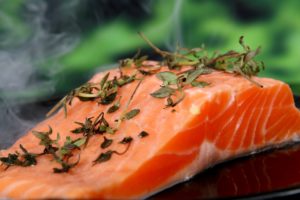
Vitamin D is 1 nutrient that Americans aren’t getting enough of, especially during the winter! It is considered a “nutrient of concern” in the 2015 Dietary Guidelines for Americans. Often called the “sunshine vitamin,” the best dose of vitamin D comes directly from ultraviolet B rays, not foods. And of the foods that do contain Vitamin D, Americans aren’t eating enough. Some reports show that 40-80% of Americans are vitamin D deficient. Are you?
No need to wonder any longer. Find out ALL you need to know and how you can take action.
What does vitamin D do for my body?
While vitamin D is known as the nutrient that helps us absorb calcium, it does a whole lot more than that! These are just a few of the important roles that vitamin D plays in your body:
- Helps the body absorb calcium in the gut
- Aids in bone growth and repair
- Involved in healthy immune function
- Reduces inflammation in the body
- Helps regulate blood pressure
- Keeps abnormal cells from multiplying in the breast and colon tissues
- Helps regulate blood sugar levels in the pancreas
Who is at risk for vitamin D deficiency?
Several factors influence your ability to synthesize vitamin D including, age, location on planet, skin pigmentation, and weight.
- Individuals with dark skin- higher amounts of melanin prevent the body from converting UVB rays to vitamin D
- Older adults- aging reduces the body’s ability efficiently synthesize vitamin D
- Breastfed infants- breast milk is low in vitamin D
- Anyone with limited sun exposure
- People who cannot absorb fat well- gastric bypass/duodenal switch patients, those with celiac disease or inflammatory bowel diseases
- Individuals with BMI greater than 30
Those practicing a vegetarian or vegan diet as well as those with a milk allergy are unable to consume common food sources of vitamin D. This requires them to depend on sunlight for adequate levels of vitamin D.
What are the concerns with low vitamin D (deficiency)?
There is increased risk in all of the following conditions:
- Rickets (children) or osteomalacia (adults)- soft bones
- Osteoporosis– reduced bone mass causing weakness and fragility
- Cardiovascular disease
- Hypertension (high blood pressure)
- Autoimmune diseases
- Depression
- Diabetes

How do I find out my vitamin D status?
The only way to determine your current vitamin D status is through a simple blood draw. The test results are usually available within a few days. While a Registered Dietitian can assess your intake of vitamin D through foods and supplements, there is no way of knowing how efficiently your body is absorbing this nutrient without this quick test.
Your physician may or may not bring up testing your vitamin D status during your appointment but all you need to do is ask. Most healthcare providers will be happy to order the test, especially if you mention a family history of osteoporosis.
How much vitamin D do I need?
The Food & Nutrition Board at the Institutes of Medicine created the Recommended Dietary Allowances for vitamin D. This is the “average daily level of intake sufficient to meet the nutrient requirements of nearly all (97%–98%) healthy people.”
- Birth to 12 months: 400 IU
- Children 1-13 years: 600 IU
- Teens 14-18 years: 600 IU
- Adults 19-70 years: 600 IU
- Adults 71 years and older: 800 IU
- Pregnant and breastfeeding women: 600 IU
Unless you are very young or old, 600IU has been determined to be “sufficient” for most individuals, but if you are already deficient or a person who has difficulty absorbing vitamin D, 600IU won’t be enough.
NOTE: Babies that are solely breastfed should be supplemented with 400iu vitamin D (look for Vitamin D supplement drops like these) as soon as they arrive home from the hospital. Formula contains vitamin D and is usually sufficient for formula-only babies. If breastfed babies are supplemented with formula, talk with your pediatrician about whether you should supplement with vitamin D.
What is the best way to meet my vitamin D needs?
Sunlight exposure is one of the best ways to meet your body’s vitamin D needs. UVB rays penetrate the skin turning cholesterol into vitamin D. During the summer, sunlight exposure might not be a big challenge, but during the winter it becomes quite the dilemma. A majority of individuals work indoors and coupled with natural weather conditions (cold, rain, snow and ice), it is even more difficult for most individuals to meet their needs for vitamin D.

How much sunlight exposure do you need to make vitamin D?
Some research suggests that individuals need 5-30 minutes of sunlight exposure between 10am and 3pm at least twice a week to meet daily vitamin D needs. However, it is difficult to give specific exposure recommendations since there are many variables that affect vitamin D production. Hre are a few things you should know:
- UVB radiation does not penetrate glass (you can’t make vitamin d behind glass)
- Total cloud cover reduces UV radiation by ~50%
- Pollution and shade reduce UV radiation by ~60%
- Sunscreen blocks UVB rays, however most don’t apply according to directions
- You don’t need to tan or burn in order to get vitamin d
- The more skin exposed, the more vitamin D you produce
- The closer to the equator, the easier it is for your body to produce vitamin D
- Pale skin produces vitamin D quickly but dark skin takes longer due to melanin
NOTE: The American Academy of Dermatology recommends Americans obtain adequate vitamin D from food and supplementation. They do not recommend unprotected sun exposure.
What foods have vitamin D?
Compared to other nutrients, very few foods have naturally occuring vitamin D. Dairy, specifically milk, is fortified with about 25% of your daily needs. Other foods fortified include some cereals, margarine, and orange juice. Interestingly, only some brands fortify yogurt and cottage cheese with vitamin D and those that do may not list exactly how much is added. Cheese is generally not fortified.
Plant-based milks do not have naturally occuring vitamin D but some brands fortify them. It’s always smart to check and see how these nutrients compare to dairy milk since it is used as a “substitute.”
One of the BEST ways to get vitamin D through food is to eat the recommended 8-12 ounces of fatty fish each week. Salmon, tuna and mackerel are all excellent sources of vitamin D in addition to those necessary omega-3 fatty acids. Just 4 ounces of salmon supplies you with an entire day’s worth of vitamin D. Sardines supply a nice boost too, if that is your thing.
There are a few other foods worth recognizing that naturally contain vitamin D including egg yolks. If you are in the habit of eating the whites only, you are missing out on nutrients! Whole eggs are rich in protein and nutrients- perfect for breakfast, lunch, dinner or a snack. Certain mushrooms grown in ultraviolet light contain a dose of vitamin D. But be sure to check the packaging. Chances are, if the package does not indicate how these ‘shrooms were grown, they won’t give you a vitamin D boost.

Remember most adults require at least 600-800iu per day to maintain healthy levels of vitamin D. Here is a chart to help you gauge how much you are consuming on a daily basis:
| FOOD | VITAMIN D (iu) |
| Salmon (sockeye), 3oz | ~450iu |
| Sardines, 3oz | ~160iu |
| Tuna, 3oz | ~150iu |
| Milk, cow’s, 8oz | ~115iu |
| Egg | ~40iu |
| Plant-based milk (almond, coconut, soy,hemp, etc) | check label |
| Yogurt, greek or regular | check label |
Did you know- vitamin D is a fat soluble vitamin? That means it is best absorbed with a little bit of fat at your meal.
Should I supplement?
Supplemental vitamin D is easy to find and generally low cost. D3 is more bioavailable (ready-to-use) so look for this version, but D2 is completely acceptable too. When considering how to dose, it is best to consult with your healthcare provider or a Registered Dietitian. They will likely want to order a simple blood draw to check your levels first. A Dietitian will also assess your usual intake of vitamin D through food sources and make recommendations. Don’t forget that multivitamins and some calcium supplements have vitamin D as well so make sure to share this information as well.
Once the test is evaluated, your healthcare provider can make dose-specific recommendations based on your personal needs.
However, Registered Dietitians always recommend food first. Creating an eating and lifestyle plan that maximizes your ability to obtain adequate vitamin D through sunlight and food first is ideal. Then supplementation can be used to do just that- supplement.
For those individuals with low vitamin D status, it is unlikely they will be able to boost levels through diet and lifestyle factors alone. Many need vitamin D supplementation, often high doses, in order to get their levels back to a healthy range.
Can I get too much vitamin D?
Technically, yes, although it is not common. Vitamin D toxicity does not occur from sunlight exposure because your body knows how to regulate the amount of vitamin D it makes. Because few foods contain vitamin D, it’s practically impossible to overdose via food.
Long-term intakes of high-dose supplemental vitamin D is the most plausible way someone could get too much vitamin D. According to the Office of Dietary Supplements, this would mean long-term consumption of 10,000-40,000iu per day, unmonitored.
When physicians recommend a high-dose vitamin D supplement for patients with a deficiency, the script is given for a set period of time (ie. 6 weeks) and then a follow-up appointment is scheduled to reassess levels. However, if your physician doesn’t monitor and reassess, it’s probably time to find a new healthcare provider.
NOTE: Some medications have potential interactions with supplemental vitamin D including some steroids, weight loss drugs, seizure medications and others. This is why it is always important to list supplements along with medications on your health history and discuss any changes with your healthcare provider.
TAKE ACTION
- Get your vitamin D level checked. Set up appointment with your physician and request to have your levels test. It is a simple blood draw. Many offices do this in-house and make results available within a few days.
- Get outside and enjoy some fresh air, especially during the winter. Plan a short walk on a lunch break. Meet up with a friend to walk a trail or greenway. Schedule a lunch playdate at the park with some friends.
- Include 2 servings of fatty fish like salmon or tuna (8-12oz) weekly. You will get a large dose of vitamin D and healthy omega-3 fats!
- Choose only vitamin D fortified plant based milk OR drink cow’s milk.
- Talk with your healthcare provider about whether you should consider supplementation and how much.
Most individuals can supplement with a daily low dose to maintain vitamin D levels but some may need high-dose supplementation and monitoring.
No more guessing…
DISCLOSURE
This post contains affiliate links. If you purchase a product through this link, your cost will be the same but Healthy Inspiration will receive a small commission to help with the operating costs of this blog. Thank you for your support!
REFERENCES
- Johns Hopkins Medicine, Vitamin D & Heart
- Office of Dietary Supplements, Vitamin D
- Forrest KY1, Stuhldreher WL. Prevalence and correlates of vitamin D deficiency in US adults. Nutr Res. 2011 Jan;31(1):48-54. doi: 10.1016/j.nutres.2010.12.001.
- Penckofer, S., Kouba, J., Byrn, M., & Ferrans, C. E. (2010). Vitamin D and Depression: Where is all the Sunshine? Issues in Mental Health Nursing, 31(6), 385–393. http://doi.org/10.3109/01612840903437657
- Aranow, C. (2011). Vitamin D and the Immune System. Journal of Investigative Medicine : The Official Publication of the American Federation for Clinical Research, 59(6), 881–886. http://doi.org/10.231/JIM.0b013e31821b8755
- National Jewish Health. (2012, February 23). How vitamin D inhibits inflammation. ScienceDaily. Retrieved January 28, 2018 from www.sciencedaily.com/releases/2012/02/120223103920.htm
- Schwalfenberg, G. (2008). Vitamin D and diabetes: Improvement of glycemic control with vitamin D3 repletion. Canadian Family Physician, 54(6), 864–866.
FREE 15 Fast Snacks that Won't Leave You Hungry

Tired of boring snacks? Want to know what to stock in your pantry and fridge to keep you fueled and satisfy cravings? Grab this yummy handout and sign up for my newsletter. Take one step today for your health!
